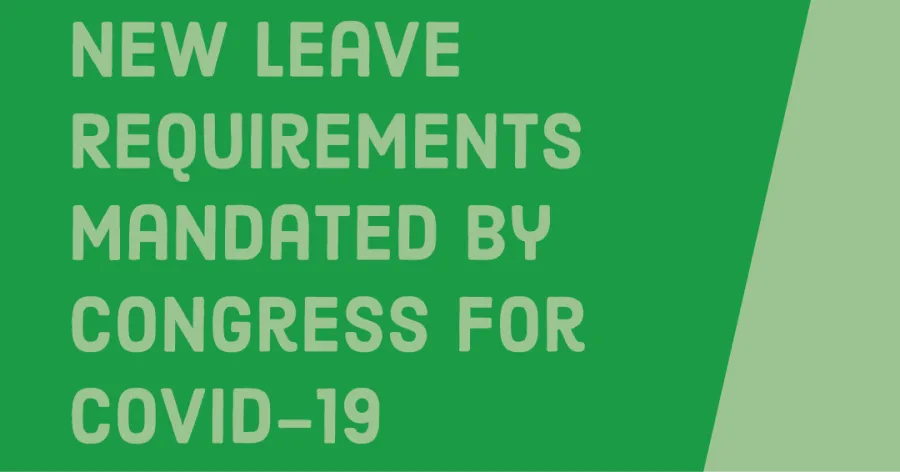New COVID 19 Leave Requirements Mandated By Congress

March 28, 2020
A new federal law enacted in response to the coronavirus crisis creates a temporary right to paid leave. However, not all employers are required to provide the leave and not all employees will be eligible for it. This fact sheet provides an overview of the rights and requirements in this new law. It has been updated from an earlier version to reflect changes to the law enacted by Congress in the Coronavirus Aid, Relief and Economic Security (CARES) Act on March 27, 2020, and new guidance issued by the U.S. Department of Labor (DOL).
What kind of leave is required to be provided?
Two kinds of leave are required. Emergency paid sick leave is the most widely available leave of the two kinds but is provided for only two weeks. Emergency family leave is available for a longer period butonly in very limited circumstanceswhena parentneedsto care for a child.An employee generally would take emergency paid sick leave before taking emergency family leave.
For what reasons can an employee take leave?
Emergency paid sick leave is available only when an employee is unable to work (or to telework) due to any of the following reasons related to COVID-19:
1. The employee is under an official quarantine or isolation order.
2. The employee has been advised by a health care provider to self-quarantine.
3. The employee is experiencing COVID-19 symptoms and seeking a medical diagnosis.
4. The employee is caring for an individual who is under an official quarantine or isolation
order or who has been advised by a health care provider to self-quarantine.
5. The employee is caring for a son or daughter under 18 years old if the child’s school or place of care has been closed, or childcare provider is unavailable, due to COVID-19
precautions.
6. The employee is experiencing substantially similar conditions to those listed above, as
specified in the future by the U.S. Secretary of Health and Human Services. (To date, the federal government has not identified any substantially similar conditions that would entitle an employee to this leave.)
Emergency family leave is available only when an employee is unable to work (or to telework) due to a need to care for the employee’s son or daughter under 18 years old if the child’s school or place of care has been closed, or childcare provider is unavailable. An employee is entitled to this leave only when the closure or unavailability is due to an officially declared COVID-19 public health emergency. By comparison, emergency paid sick leave is available when the closure or childcare provider’s unavailability is due to COVID- 19 precautions.
How long is the leave?
Emergency paid sick leave can be taken for up to two weeks. For a full-time employee, this means 80 hours. For a part-time employee, it is the average of hours worked over a 2-week period.
Emergency family leave can be taken for up to 12 weeks. While the first two weeks (i.e., 10 days) of it may be unpaid, the expectation is that an employee will take emergency paid sick leave during that time.
How much does an employee get paid while on leave?
When taking emergency paid sick leave to care for oneself (reasons 1–3 under “For what reasons can an employee take leave?”), an employee is paid 100% of the employee’s regular rate of pay multiplied by the number of hours the employee would normally be scheduled to work. Pay is capped at $511 per day and $5,110 total.
When taking this leave to care for others or for other reasons (reasons 4–6), an employee is paid two-thirds of the employee’s regular rate of pay multiplied by the number of hours. Pay is capped at $200 per day and $2,000 total.
After the first 10 days of emergency family leave, an employee is paid two-thirds of the employee’s regular rate of pay multiplied by the number of hours the employee would normally be scheduled to work. Pay is capped at $200 per day and $10,000 total.
Which employers are required to provide this leave?
• Private-sector employers with fewer than 500 employees.
• Government employers of any size.
Exemption for Small Businesses—The U.S. Secretary of Labor can exempt small businesses with fewer than 50 employees from this requirement when imposing this requirement would jeopardize the viability of the business as a going concern.
Which employees are eligible for paid leave?
• Emergency paid sick leave—Any employee, regardless of hours of work or length of service.
• Emergency Family and Medical Leave—Employees who have been employed for at least 30 calendar days by their employer. Special rules apply of employees laid off on or after March 1, 2020, and then rehired.
Exclusion of Certain Health Care Providers and Emergency Responders—An employer can deny either kind of leave to employees who are health care providers or first responders. Also, the U.S. Secretary of Labor can issue regulations excluding these workers from eligibility. It is not clear which workers will be considered to be health care providers or emergency responders. Existing Labor Department rules define health care provider relatively narrowly to include jobs like medical doctors, dentists, nurse practitioners, physician assistants, nurse mid-wives and clinical social workers. The Labor Department might try to broaden the definition to include other kinds of workers, such as those in the nursing profession.
Exclusion of Some Federal Government Employees—While all federal employees are eligible for emergency paid sick leave, most federal employees are not eligible for emergency family leave. Some examples of federal employees who are eligible for emergency family leave include employees of the Federal Aviation Administration, the Library of Congress and the U.S. Postal Service. The Director of the Office of Management and Budget can deny either kind of leave to certain executive branch employees.
How do these new leave requirements relate to leave provided for under collective bargaining agreements, employer policies or other laws?
Emergency paid sick leave and emergency family leaveare in addition to employees’ preexisting leave entitlements. If an employee is eligible to take emergency paid sick leave or emergency family leave, as well as paid leave already provided by an employer, the employee chooses which type of leave to take. The employer cannot require an employee to take a particular form of leave.
In cases in which an employee is entitled to two-thirds pay under the new law, an employer could allow an employee to take other existing paid leave (e.g., vacation, personal, medical or sick leave) concurrently with emergency paid sick leave or emergency family leave to supplement that partial pay up to the employee’s normal earnings. An employer is not required to do this and cannot require an employee to take other leave concurrently with emergency leave.
The new law states that emergency paid sick leave does not diminish an employee’s rights or benefits under any other law, collective bargaining agreement or existing employer policy. Any employee who separates from employment is not entitled to payment for any unused emergency paid sick leave.
An employee can choose to take any accrued vacation leave, personal leave or medical or sick leave for the unpaid first two weeks of emergency family leave. Generally, an employee would be likely to take emergency paid sick leave during that period. An employer cannot require an employee to take other kinds of accrued leave instead of the emergency family leave.
Since this new leave is temporary, when will eligible employees have a right to this leave?
These temporary requirements are in effect during the period that begins on April 1, 2020, and ends on December 31, 2020. The law does not create a right to pay for leave taken before April 1. Further, an employer may not count leave taken prior to April 1 toward the amount of leave an employee is owed under these new requirements.
Does the federal government provide any financial assistance to help employers pay for this leave?
The new law includessignificanttax benefitsonlyforprivate-sector employers.Itdoes not provide any financial assistance to government employers even though allgovernment employers are required to provide this paid leave. The benefits provided to private-sector employers include:
• Refundable tax credits that generally cover the cost of the leave, the cost of an employee’s health benefits paid by the employer during the leave period and the amount the employer pays in Medicare payroll tax on the leave pay.
• An exemption from paying the employer share of the Social Security payroll tax on the employee’s pay during the leave period.
This federal financial assistance is available only to private-sector employers for leave amounts they are required to pay under the new law. For example, if a private-sector employer with 500 or more employees chooses to provide either kind of leave, it would not be eligible for these tax credits. Also, if an employer covered by the new leave requirements chooses to increase the amount it pays an employee taking leave to care for another individual above the two-thirds of pay mandated under the law, it would not be eligible for these tax credits on the extra amount.
